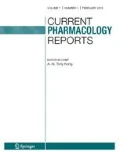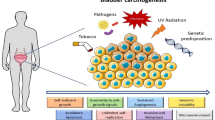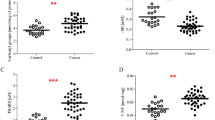Abstract
Oxidative stress is a driver of many diseases, including cancer. Nuclear factor (erythroid-derived 2) like 2 (Nrf2 or NFE2L2) provides cellular defense against oxidative stress by regulating antioxidant response element (ARE)-mediated phase II detoxifying/antioxidant enzymes. This protective role is evident from studies on bladder cancer (BCa) pathogenesis. This article reviews the impact of excessive oxidative stress on bladder carcinogenesis, aiming to understand what is happening from an epidemiological perspective concerning its burden and management, as well as to discuss the challenges including high relapse rate. Two measures are proposed for reducing the burden and better management: first, promote early diagnosis of BCa with fluorescence cystoscopy; second, increase dietary intake of nutraceuticals that demonstrate functional antioxidative Nrf2. Such an integrative approach may provide a better prognostic outcome for BCa patients or people who are at higher risk of developing BCa.




Similar content being viewed by others
References
Siegel RL, Miller KD, Jemal A. Cancer statistics, 2017. CA Cancer J Clin. 2017;67:7–30.
Berenblum I, Armuth V. Two independent aspects of tumor promotion. Biochim Biophys Acta. 1981;651:51–63.
Heidelberger C, Freeman AE, Pienta RJ, Sivak A, Bertram JS, Casto BC, et al. Cell transformation by chemical agents—a review and analysis of the literature. A report of the U.S. Environmental Protection Agency Gene-Tox Program. Mutat Res. 1983;114:283–385.
Weinberg F, Chandel NS. Reactive oxygen species-dependent signaling regulates cancer. Cell Mol Life Sci. 2009;66:3663–73.
Mantovani A, Allavena P, Sica A, Balkwill FA. Cancer-related inflammation. Nature. 2008;454:436–44.
Letašiová S, Medve’ová A, Šovčíková A, Dušinská M, Volkovová K, Mosoiu C, et al. Bladder cancer, a review of the environmental risk factors. Environ Health. 2012;11(Suppl 1):S11.
Flora SJS. Arsenic-induced oxidative stress and its reversibility. Free Radic Biol Med. 2011;51:257–81.
Steward WP, Brown K. Cancer chemoprevention: a rapidly evolving field. Br J Cancer. 2013;109(1):1–7.
Sporn MB. Approaches to prevention of epithelial cancer during the preneoplastic period. Cancer Res. 1976;36:2699–702.
Hu R, Saw CL-L, Yu R, Kong A-NT. Regulation of NF-E2-related factor 2 signaling for cancer chemoprevention: antioxidant coupled with antiinflammatory. Antioxid Redox Signal. 2010;13:1679–98.
Talalay P, Fahey JW, Holtzclaw WD, Prestera T, Zhang Y. Chemoprotection against cancer by phase 2 enzyme induction. Toxicol Lett. 1995;82–83:173–9.
Paredes-Gonzalez X, Fuentes F, Jeffery S, Saw CL-L, Shu L, Su Z-Y, et al. Induction of NRF2-mediated gene expression by dietary phytochemical flavones apigenin and luteolin. Biopharm Drug Dispos. 2015;36:440–51.
Saw CLL, Guo Y, Yang AY, Paredes-Gonzalez X, Ramirez C, Pung D, et al. The berry constituents quercetin, kaempferol, and pterostilbene synergistically attenuate reactive oxygen species: involvement of the Nrf2-ARE signaling pathway. Food Chem Toxicol. 2014;72:303–11.
Saw CLL, Yang AY, Guo Y, Kong A-NT. Astaxanthin and omega-3 fatty acids individually and in combination protect against oxidative stress via the Nrf2-ARE pathway. Food Chem Toxicol. 2013;62:869–75.
Saw CLL, Wu Q, Su Z-Y, Wang H, Yang Y, Xu X, et al. Effects of natural phytochemicals in Angelica sinensis (Danggui) on Nrf2-mediated gene expression of phase II drug metabolizing enzymes and anti-inflammation. Biopharm Drug Dispos. 2013;34:303–11.
Wang H, Khor TO, Yang Q, Huang Y, Wu T-Y, Saw CL-L, et al. Pharmacokinetics and pharmacodynamics of phase II drug metabolizing/antioxidant enzymes gene response by anticancer agent sulforaphane in rat lymphocytes. Mol Pharm. 2012;9:2819–27.
Saw CLL, Yang AY, Cheng DC, Boyanapalli SS-S, Su Z-Y, Khor TO, et al. Pharmacodynamics of ginsenosides: antioxidant activities, activation of Nrf2, and potential synergistic effects of combinations. Chem Res Toxicol. 2012;25:1574–80.
Saw CL-L, Cintrón M, Wu T-Y, Guo Y, Huang Y, Jeong W-S, et al. Pharmacodynamics of dietary phytochemical indoles I3C and DIM: induction of Nrf2-mediated phase II drug metabolizing and antioxidant genes and synergism with isothiocyanates. Biopharm Drug Dispos. 2011;32:289–300.
Slocum SL, Kensler TW. Nrf2: control of sensitivity to carcinogens. Arch Toxicol. 2011;85:273–84.
Saw CLL, Yang AY, Huang M-T, Liu Y, Lee JH, Khor TO, et al. Nrf2 null enhances UVB-induced skin inflammation and extracellular matrix damages. Cell Biosci. 2014;4:39.
Saw CL, Huang M-T, Liu Y, Khor TO, Conney AH, Kong A-N. Impact of Nrf2 on UVB-induced skin inflammation/photoprotection and photoprotective effect of sulforaphane. Mol Carcinog. 2011;50:479–86.
Nguyen T, Nioi P, Pickett CB. The Nrf2-antioxidant response element signaling pathway and its activation by oxidative stress. J Biol Chem. 2009;284:13291–5.
Cheng D, Wu R, Guo Y, Kong A-NT. Regulation of Keap1–Nrf2 signaling: the role of epigenetics. Curr Opin Toxicol. 2016;1:134–8.
Huang Y, Li W, Su Z-Y, Kong ANT. The complexity of the Nrf2 pathway: beyond the antioxidant response. J Nutr Biochem. 2015;26:1401–13.
Tang L, Zirpoli GR, Guru K, Moysich KB, Zhang Y, Ambrosone CB, et al. Intake of cruciferous vegetables modifies bladder cancer survival. Cancer Epidemiol Biomarkers Prev. 2010;19:1806–11.
Veeranki OL, Bhattacharya A, Tang L, Marshall JR, Zhang Y. Cruciferous vegetables, isothiocyanates, and prevention of bladder cancer. Curr Pharmacol Rep. 2015;1:272–82.
Borden LS, Clark PE, Hall MC. Bladder cancer. Curr Opin Oncol. 2005;17:275–80.
Babjuk M, Böhle A, Burger M, Capoun O, Cohen D, Compérat EM, et al. EAU guidelines on non-muscle-invasive urothelial carcinoma of the bladder: update 2016. Eur Urol. 2017;71:447–61.
Soini Y, Haapasaari K-M, Vaarala MH, Turpeenniemi-Hujanen T, Kärjä V, Karihtala P. 8-hydroxydeguanosine and nitrotyrosine are prognostic factors in urinary bladder carcinoma. Int J Clin Exp Pathol. 2011;4:267–75.
Cookson MS, Herr HW, Zhang Z-F, Soloway S, Sogani PC, Fair WR. The treated natural history of high risk superficial bladder cancer: 15-year outcome. J Urol. 1997;158:62–7.
Spiess PE, Grossman HB. Fluorescence cystoscopy: is it ready for use in routine clinical practice? Curr Opin Urol. 2006;16:372–6.
D’Hallewin M-A, Vanherzeele H, Baert L Fluorescence detection of bladder cancer. In: Petrovich Z, Baert L, Brady LW, editors. Carcinoma of the Bladder. Medical Radiology (Diagnostic Imaging and Radiation Oncology) [Internet]. Berlin, Heidelberg: Springer 1998; p. 113–25. Available from: https://link.springer.com/chapter/10.1007/978-3-642-60258-0_10.
Lamm DL. Carcinoma in situ. Urol Clin North Am. 1992;19:499–508.
American Urological Association - Diagnosis and treatment of non-muscle invasive bladder cancer: AUA/SUO joint guideline [Internet]. [cited 2018 Jan 11]. Available from: http://www.auanet.org/guidelines/non-muscle-invasive-bladder-cancer-(aua/suo-joint-guideline-2016)#x2560.
Gregorie HB, Horger EO, Ward JL, Green JF, Richards T, Robertson HC, et al. Hematoporphyrin-derivative fluorescence in malignant neoplasms. Ann Surg. 1968;167:820–8.
D’Hallewin M-A, Kamuhabwa AR, Roskams T, De Witte PAM, Baert L. Hypericin-based fluorescence diagnosis of bladder carcinoma. BJU Int. 2002;89:760–3.
Straub M, Russ D, Horn T, Gschwend JE, Abrahamsberg C. A phase IIA dose-finding study of PVP-hypericin fluorescence cystoscopy for detection of nonmuscle-invasive bladder cancer. J Endourol. 2015;29:216–22.
Saw CLL, Olivo M, Chin WWL, Soo KC, Heng PWS. Superiority of N-methyl pyrrolidone over albumin with hypericin for fluorescence diagnosis of human bladder cancer cells implanted in the chick chorioallantoic membrane model. J Photochem Photobiol B. 2007;86:207–18.
Saw CLL, Olivo M, Soo KC, Heng PWS. Spectroscopic characterization and photobleaching kinetics of hypericin-N-methyl pyrrolidone formulations. Photochem Photobiol Sci. 2006;5:1018–23.
Saw CLL, Olivo M, Soo KC, Heng PWS. Delivery of hypericin for photodynamic applications. Cancer Lett. 2006;241:23–30.
Jiang B, Dong Y, He H, Han C. Application of pirarubicin photosensitizer fluorescence cystoscopy in early detection of bladder cancer. Oncol Lett. 2017;14:3309–12.
Peng Q, Warloe T, Berg K, Moan J, Kongshaug M, Giercksky K-E, et al. 5-Aminolevulinic acid-based photodynamic therapy. Cancer. 1997;79:2282–308.
Novo M, Hüttmann G, Diddens H. Chemical instability of 5-aminolevulinic acid used in the fluorescence diagnosis of bladder tumours. J Photochem Photobiol B. 1996;34:143–8.
Saw CLL, Heng PWS. Hypericin. In: Schwab M, editor. Encyclopedia of Cancer [Internet]. Berlin, Heidelberg: Springer 2017. https://doi.org/10.1007/978-3-662-46875-3_2908.
Lerner SP, Goh A. Novel endoscopic diagnosis for bladder cancer. Cancer. 2015;121:169–78.
D’Hallewin MA, De Witte PA, Waelkens E, Merlevede W, Baert L. Fluorescence detection of flat bladder carcinoma in situ after intravesical instillation of hypericin. J Urol. 2000;164:349–51.
Sim HG, Lau WKO, Olivo M, Tan PH, Cheng CWS. Is photodynamic diagnosis using hypericin better than white-light cystoscopy for detecting superficial bladder carcinoma? BJU Int. 2005;95:1215–8.
Kubin A, Meissner P, Wierrani F, Burner U, Bodenteich A, Pytel A, et al. Fluorescence diagnosis of bladder cancer with new water soluble hypericin bound to polyvinylpyrrolidone: PVP-hypericin. Photochem Photobiol. 2008;84:1560–3.
Akçay T, Saygili I, Andican G, Yalçin V. Increased formation of 8-hydroxy-2′-deoxyguanosine in peripheral blood leukocytes in bladder cancer. Urol Int. 2003;71:271–4.
Opanuraks J, Boonla C, Saelim C, Kittikowit W, Sumpatanukul P, Honglertsakul C, et al. Elevated urinary total sialic acid and increased oxidative stress in patients with bladder cancer. Asian Biomed. 2010;4:703–10.
Perše M, Injac R, Erman A. Oxidative status and lipofuscin accumulation in urothelial cells of bladder in aging mice. PLoS One. 2013;8:e59638.
Lawrence T. The nuclear factor NF-κB pathway in inflammation. Cold Spring Harb Perspect Biol [Internet]. 2009;1. Available from: https://www.ncbi.nlm.nih.gov/pmc/articles/PMC2882124/
Tripathi DN, Jena GB. Effect of melatonin on the expression of Nrf2 and NF-kappaB during cyclophosphamide-induced urinary bladder injury in rat. J Pineal Res. 2010;48:324–31.
Wongpaiboonwattana W, Tosukhowong P, Dissayabutra T, Mutirangura A, Boonla C. Oxidative stress induces hypomethylation of LINE-1 and hypermethylation of the RUNX3 promoter in a bladder cancer cell line. Asian Pac J Cancer Prev. 2013;14:3773–8.
Yager JW, Gentry PR, Thomas RS, Pluta L, Efremenko A, Black M, et al. Evaluation of gene expression changes in human primary uroepithelial cells following 24-Hr exposures to inorganic arsenic and its methylated metabolites. Environ Mol Mutagen. 2013;54:82–98.
Iida K, Itoh K, Kumagai Y, Oyasu R, Hattori K, Kawai K, et al. Nrf2 is essential for the chemopreventive efficacy of oltipraz against urinary bladder carcinogenesis. Cancer Res. 2004;64:6424–31.
Sporn MB, Liby KT. NRF2 and cancer: the good, the bad and the importance of context. Nat Rev Cancer. 2012;12:564–71.
Reszka E, Jablonowski Z, Wieczorek E, Jablonska E, Krol MB, Gromadzinska J, et al. Polymorphisms of NRF2 and NRF2 target genes in urinary bladder cancer patients. J Cancer Res Clin Oncol. 2014;140:1723–31.
Qi Z-P, Zhao E-J, Li B, Bai R-X. Glutathione S-transferase M1 polymorphism and bladder cancer risk: a meta-analysis involving 50 studies. Int J Clin Exp Pathol. 2017;10:3209–18.
Reszka E, Jablonowski Z, Wieczorek E, Gromadzinska J, Jablonska E, Sosnowski M, et al. Expression of NRF2 and NRF2-modulated genes in peripheral blood leukocytes of bladder cancer males. Neoplasma. 2013;60:123–8.
Savic-Radojevic A, Djukic T, Simic T, Pljesa-Ercegovac M, Dragicevic D, Pekmezovic T, et al. GSTM1-null and GSTA1-low activity genotypes are associated with enhanced oxidative damage in bladder cancer. Redox Rep. 2013;18:1–7.
Hayden A, Douglas J, Sommerlad M, Andrews L, Gould K, Hussain S, et al. The Nrf2 transcription factor contributes to resistance to cisplatin in bladder cancer. Urol Oncol Semin Orig Investig. 2014;32:806–14.
Saw CL-L, Wu Q, Kong A-NT. Anti-cancer and potential chemopreventive actions of ginseng by activating Nrf2 (NFE2L2) anti-oxidative stress/anti-inflammatory pathways. Chin Med. 2010;5:37.
Satoh H, Moriguchi T, Takai J, Ebina M, Yamamoto M. Nrf2 prevents initiation but accelerates progression through the Kras signaling pathway during lung carcinogenesis. Cancer Res. 2013;73:4158–68.
Lee JH, Khor TO, Shu L, Su Z-Y, Fuentes F, Kong A-NT. Dietary phytochemicals and cancer prevention: Nrf2 signaling, epigenetics, and cell death mechanisms in blocking cancer initiation and progression. Pharmacol Ther. 2013;137:153–71.
Wang H, Khor TO, Shu L, Su Z, Fuentes F, Lee J-H, et al. Plants against cancer: a review on natural phytochemicals in preventing and treating cancers and their druggability. Anti Cancer Agents Med Chem. 2012;12:1281–305.
Su Z-Y, Shu L, Khor TO, Lee JH, Fuentes F, Tony Kong A-N. A perspective on dietary phytochemicals and cancer chemoprevention: oxidative stress, Nrf2, and epigenomics. Top Curr Chem. 2013;329:133–62.
Finley JW, Kong A-N, Hintze KJ, Jeffery EH, Ji LL, Lei XG. Antioxidants in foods: state of the science important to the food industry. J Agric Food Chem. 2011;59:6837–46.
Berger RG, Lunkenbein S, Ströhle A, Hahn A. Antioxidants in food: mere myth or magic medicine? Crit Rev Food Sci Nutr. 2012;52:162–71.
Hock LC. An overview of the cancer control programme in Singapore. Jpn J Clin Oncol. 2002;32:S62–5.
Acknowledgments
The author would like to thank Chung Ling Quek at Singapore Health Services (Singhealth), Singapore for reading of this manuscript. Thanks also go to Dr. Chee Loong Saw and Dr. Simran Kaur at McGill University for their helpful comments.
Funding
This review is not funded by any parties.
Author information
Authors and Affiliations
Corresponding author
Ethics declarations
Conflict of Interest
The authors declare that they have no conflicts of interest.
Human and Animal Rights and Informed Consent
This article does not contain any studies with human or animal subjects performed by any of the authors.
Additional information
This article is part of the Topical Collection on Cancer Chemoprevention
Rights and permissions
About this article
Cite this article
Saw, C.L.L. Oxidative Stress and Bladder Cancer Carcinogenesis: Early Detection and Chemoprevention Involving Nrf2—an Integrative Approach. Curr Pharmacol Rep 4, 482–490 (2018). https://doi.org/10.1007/s40495-018-0163-0
Published:
Issue Date:
DOI: https://doi.org/10.1007/s40495-018-0163-0




